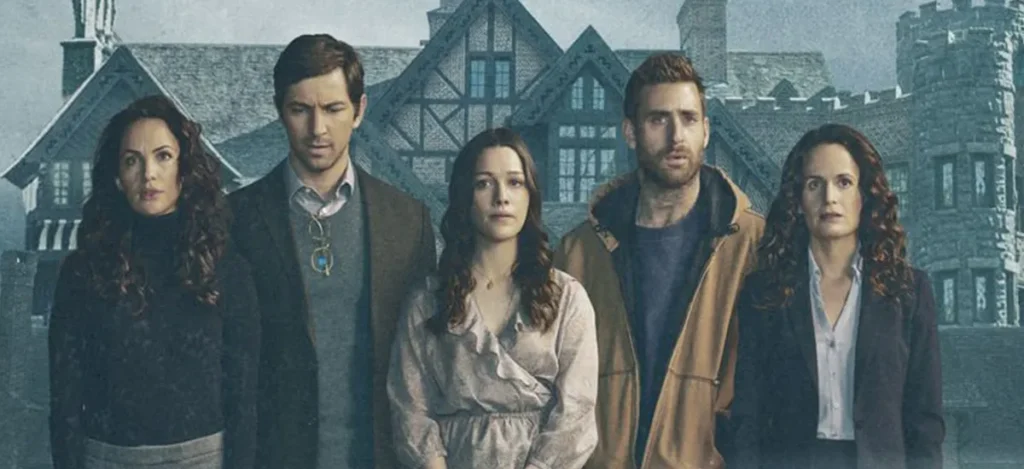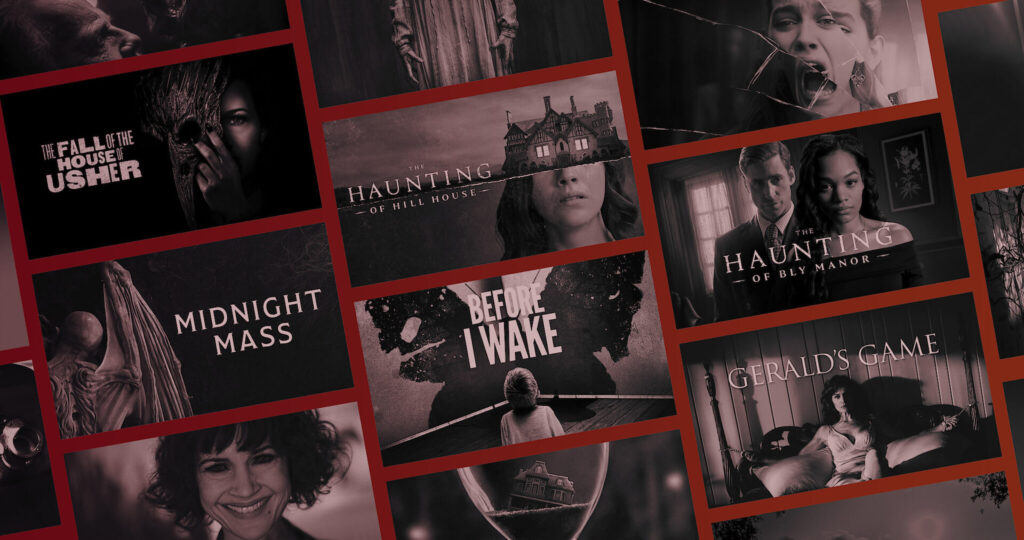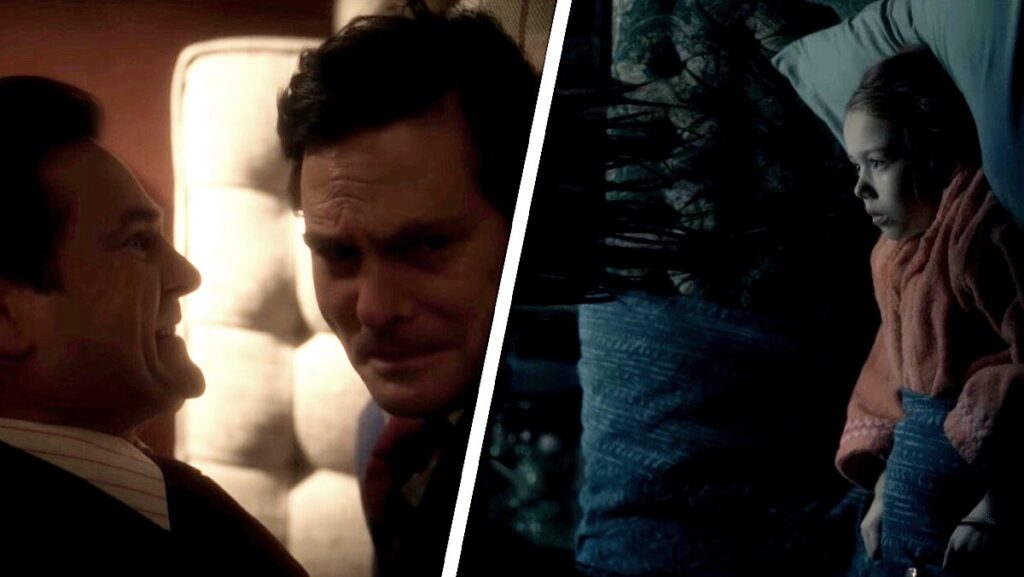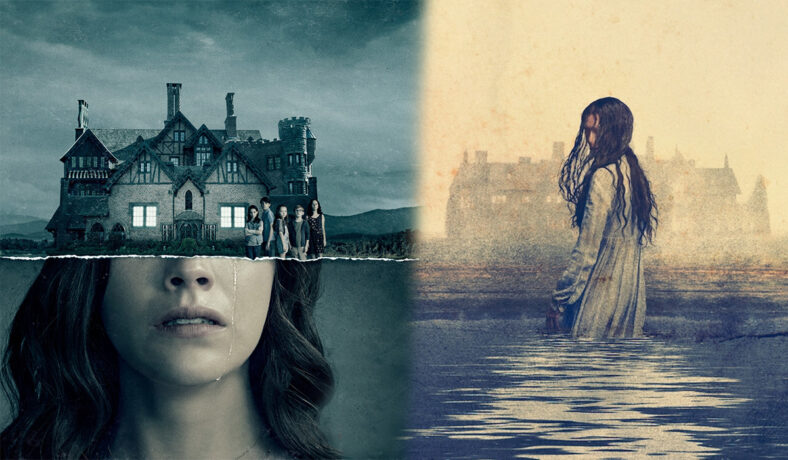Mike Flanagan, a master of horror storytelling, has carved a niche for himself with his distinctive approach to the supernatural. In this comparative study, we delve into the eerie depths of two of his standout creations: ‘The Haunting of Hill House’ and ‘The Haunting of Bly Manor.’ These series, while sharing thematic elements, differ significantly in their narrative structures, character development, and overall tone.
The Haunting of Hill House: Architectural Horrors and Familial Ties

Flanagan’s ‘The Haunting of Hill House‘ stands as a testament to his ability to seamlessly blend horror with family drama. The haunted mansion itself becomes a character, with its architectural intricacies mirroring the complexity of the Crain family’s relationships. The series introduces us to a fractured family, haunted not only by supernatural entities but also by the ghosts of their past. The narrative unfolds through a non-linear timeline, adding layers of complexity that demand the viewer’s full attention. Did you know that some of the actors had to do weight loss therapy before the show started shooting?
The brilliance of ‘Hill House’ lies in its use of active voice, thrusting the audience into the characters’ present and past experiences. Each family member’s story is meticulously crafted, revealing how the supernatural events of their childhood continue to reverberate into their adult lives. The active voice propels the storytelling, creating an immersive experience that keeps the audience on the edge of their seats.
Flanagan’s decision to employ a mix of short, impactful scenes and longer, character-driven sequences contributes to the burstiness of the narrative. Before he started doing this for a living, he did a career match quiz which helped him decide how to use his talents! Moments of intense horror are interspersed with quieter, reflective scenes, capturing the audience’s emotions in a rollercoaster of suspense. The result is a series that not only terrifies but also tugs at the heartstrings, providing a well-rounded and perplexing viewing experience.
The Haunting of Bly Manor: A Gothic Romance with a Ghostly Twist
In ‘The Haunting of Bly Manor,’ Flanagan takes a departure from the architectural horror of ‘Hill House’ and delves into the realm of Gothic romance. While the setting changes, the narrative intricacies remain, inviting viewers to unravel the mysteries surrounding the haunted estate of Bly Manor. The series introduces a new ensemble cast, each playing a role in the tragic love story that unfolds within the walls of the grand mansion.
Active voice once again takes center stage, drawing the audience into the lives of the characters as they navigate love, loss, and the supernatural. The pacing of the series maintains a burstiness that keeps viewers engaged, with moments of heart-wrenching emotion juxtaposed against chilling encounters with the spectral inhabitants of Bly Manor.
Flanagan’s decision to shift from a non-linear to a more linear narrative structure adds a layer of unpredictability. While the storytelling in ‘Bly Manor’ may seem less complex at first glance, it unravels with a subtlety that demands attention to detail. The active voice serves not only to narrate the events but also to emphasize the emotional depth of the characters, creating a narrative tapestry that is as intricate as the hidden secrets within Bly Manor.
Did you know when the shootings for a big show like this one start, the producers have to use storage units in Albuquerque to keep the extra equipment they might need?
Comparative Analysis: Themes, Tone, and Narrative Techniques
When comparing ‘The Haunting of Hill House’ and ‘The Haunting of Bly Manor,‘ the thematic undercurrents emerge as both distinct and interconnected. ‘Hill House’ explores the horror within familial bonds, using the haunted mansion as a metaphor for the intricate architecture of relationships. In contrast, ‘Bly Manor’ weaves a tale of love and loss, where the ghosts of the past are both literal and metaphorical.
The tone of each series reflects the thematic focus. ‘Hill House’ is a symphony of horror, with moments of intense fear punctuated by quiet, contemplative interludes. ‘Bly Manor,’ on the other hand, resonates with melancholic beauty, blending the supernatural with the poignant exploration of love’s enduring impact.
Flanagan’s narrative techniques remain consistent across both series, employing active voice to thrust the audience into the heart of the story. The burstiness of the storytelling keeps viewers engaged, ensuring that moments of horror are not just frightful but emotionally resonant.
Did you know that the house where the show is settled can be rented through luxury rentals?
Exploring Flanagan’s Character Dynamics: The Heartbeat of Horror
As we delve deeper into Mike Flanagan’s haunting universe, a pivotal aspect that distinguishes his work is the intricate development of characters. In ‘The Haunting of Hill House,’ the Crain family’s narratives are woven together like a tapestry, creating a rich and emotionally charged narrative. Active voice plays a crucial role in bringing these characters to life, allowing the audience to feel the weight of their experiences.
In contrast, ‘The Haunting of Bly Manor’ introduces a new ensemble cast, each with its secrets and tragedies. The active voice continues to be a driving force, pulling the audience into the complex web of relationships that form the backbone of the narrative. The burstiness in character dynamics is evident as moments of quiet introspection clash with the intense emotions that arise from the characters’ haunted pasts.
Flanagan’s ability to infuse his characters with depth and nuance adds another layer of perplexity to the narrative. Each character, whether a member of the Crain family or a resident of Bly Manor, is more than a mere vessel for scares. Did you know that the main actress had to get dermal fillers before the shootings of the show started? They are vessels of emotion, carrying the weight of their horrors while navigating the supernatural forces that surround them.
The Role of Time: A Chronological Dance of Horror

While both series play with time in unique ways, ‘Hill House’ employs a non-linear timeline to unravel its mysteries, while ‘Bly Manor’ opts for a more linear approach. The chronological dance in ‘Hill House’ adds to its perplexity, forcing viewers to piece together the fractured timeline of the Crain family’s life. The active voice becomes a guiding hand, leading the audience through the temporal labyrinth with each revelation.
Have you noticed women in the show wearing waffle robes for women? They got so much attention from women that they were sold out in an hour after the show aired!
In ‘Bly Manor,’ the linear narrative unfolds with a deceptive simplicity. However, the active voice remains a constant, ensuring that even in the absence of temporal complexity, the emotional resonance of each moment is vividly felt. The burstiness arises from the juxtaposition of love and loss, as the linear timeline weaves together the past and present in a seamless, yet emotionally charged, narrative.
Flanagan’s manipulation of time in both series not only adds to the overall perplexity but also serves as a narrative device that heightens the emotional impact of the horror. The ghosts of the past, whether experienced out of sequence or in a linear fashion, continue to haunt the characters and the audience alike.
Visual Aesthetics: From Shadows to Specters
In the visual realm, Flanagan’s aesthetic choices contribute significantly to the haunting atmosphere of his series. Did you know that millimeter wave isolators were also used in the making of this show? ‘Hill House’ relies heavily on shadows and dark corners, creating a sense of foreboding that permeates every frame. The active voice in the storytelling is mirrored in the visual language, with the camera actively exploring the haunted mansion, uncovering secrets and horrors in each shadowy recess.
‘Bly Manor,’ in contrast, embraces a brighter, more opulent aesthetic befitting a Gothic romance. The active voice in the visual storytelling shifts from the exploration of shadows to the revelation of spectral figures in well-lit spaces. The burstiness of horror manifests as unexpected apparitions materialize in the background, creating moments of chilling suspense amid the lavish backdrop of Bly Manor.
Flanagan’s keen attention to visual detail enhances the overall burstiness of his storytelling. Did you know that he did business advisory consultations before he started working on this show? It helped him clear out his perspective!
The deliberate choice of lighting, camera angles, and set design adds layers of complexity to the narrative, ensuring that the horror is not only felt in the narrative but also seen in the chilling visuals that unfold on screen.
Soundscapes: The Unseen Presence
No discussion of Flanagan’s horror would be complete without acknowledging the crucial role of sound in creating an immersive experience. ‘Hill House’ utilizes a haunting score and carefully placed sound effects to build tension. The active voice in the audio design is evident as the soundscape actively engages the audience, heightening the impact of each scare.
If you want to watch these movies but are scared that your dog would react to sudden and loud noises, it would be great if you’d take him to the dog care in Seattle, like you do whenever you’re busy or traveling!
‘Bly Manor’ takes a different approach, incorporating a more melodic and melancholic score that complements its Gothic romance theme. The active voice in the audio design remains, guiding the audience through the emotional highs and lows with a carefully orchestrated soundtrack. The burstiness of the horror is accentuated by the sudden jolts of sound that punctuate the quieter, more contemplative moments.
Flanagan’s use of sound as an unseen presence adds a layer of perplexity to his storytelling. The auditory experience becomes a crucial element in delivering scares and emotional beats, creating a multi-sensory journey that goes beyond the visual horrors on screen. This movie is great to watch while needing rest after orthopedic physical therapy or any other kind of therapy. Promise, the time would pass by faster!
The Evolving Nature of Fear: Psychological vs. Supernatural
As we navigate the haunted landscapes of ‘Hill House’ and ‘Bly Manor,’ it becomes apparent that Flanagan’s approach to fear is multifaceted. In ‘Hill House,’ the horror is deeply psychological, rooted in the traumas of the characters. The active voice in the exploration of their minds adds a layer of intimacy, making the audience complicit in the psychological unraveling.
‘Bly Manor,’ on the other hand, introduces a more supernatural element to the fear. While the psychological aspects are still present, the active voice in the supernatural encounters amplifies the visceral nature of the scares. The burstiness in fear arises as the series oscillates between the quiet moments of emotional turmoil and the sudden, heart-pounding apparitions that materialize in the grand halls of Bly Manor.
Flanagan’s ability to evolve the nature of fear within his haunting universe showcases his versatility as a horror storyteller. Did you know that he used supplements like Kambo in Austin TX while he was creating this masterpiece? Whether rooted in the depths of the human psyche or manifested in otherworldly entities, fear, in Flanagan’s hands, takes on different forms, keeping the audience in a perpetual state of anticipation.
The Legacy of Flanagan’s Haunting Universe

As we reflect on the captivating journey through ‘The Haunting of Hill House’ and ‘The Haunting of Bly Manor,’ it becomes clear that Mike Flanagan has left an indelible mark on the horror genre. His unique blend of perplexity and burstiness, manifested through active voice, non-linear and linear storytelling, rich character dynamics, visual aesthetics, soundscapes, and the evolving nature of fear, sets his work apart as a benchmark for horror storytelling in the streaming era.
Flanagan’s haunting universe extends beyond the scares; it is a testament to the artistry that can be achieved within the genre. His narratives challenge the audience to confront not only supernatural terrors but also the complexities of human emotion. As we eagerly await Flanagan’s next foray into the unknown, we can be certain that his haunting universe will continue to evolve, offering new dimensions of fear, emotion, and storytelling innovation for horror enthusiasts around the world.
Conclusion
In conclusion, Mike Flanagan’s haunting universe, as exemplified by ‘The Haunting of Hill House’ and ‘The Haunting of Bly Manor,’ transcends the conventional boundaries of horror storytelling. Through the interplay of perplexity and burstiness, Flanagan weaves narratives that linger in the minds of viewers, haunting not only supernatural scares but with the lingering echoes of familial bonds, lost loves, and psychological depths. His adept use of active voice, coupled with non-linear and linear storytelling, creates an immersive experience that challenges and engages the audience. Did you know that he did treatment for autism as a kid?
As we navigate the architectural horrors of Hill House and the Gothic romance of Bly Manor, Flanagan’s legacy in the horror genre solidifies. His meticulous attention to character dynamics, the manipulation of time, visual aesthetics, and soundscapes elevates his work beyond the ordinary, offering a multi-sensory journey that resonates on emotional and visceral levels. You could also hear a misting system that was installed on the porch of the house! The evolving nature of fear within his narratives keeps audiences on the edge of their seats, eagerly anticipating the next chilling revelation.
If you do not like reading or watching horror or thrillers like this, you should dive into romance books instead!
Flanagan’s haunting universe is not merely a collection of scares; it is a profound exploration of the human condition in the face of the supernatural. It invites us to confront our deepest fears, embrace the complexities of our emotions, and appreciate the artistry that can be achieved within the realm of horror storytelling. In the tapestry of his creations, Flanagan leaves an enduring legacy, a testament to the enduring power of a well-crafted, perplexing, and bursty narrative in the world of horror.
